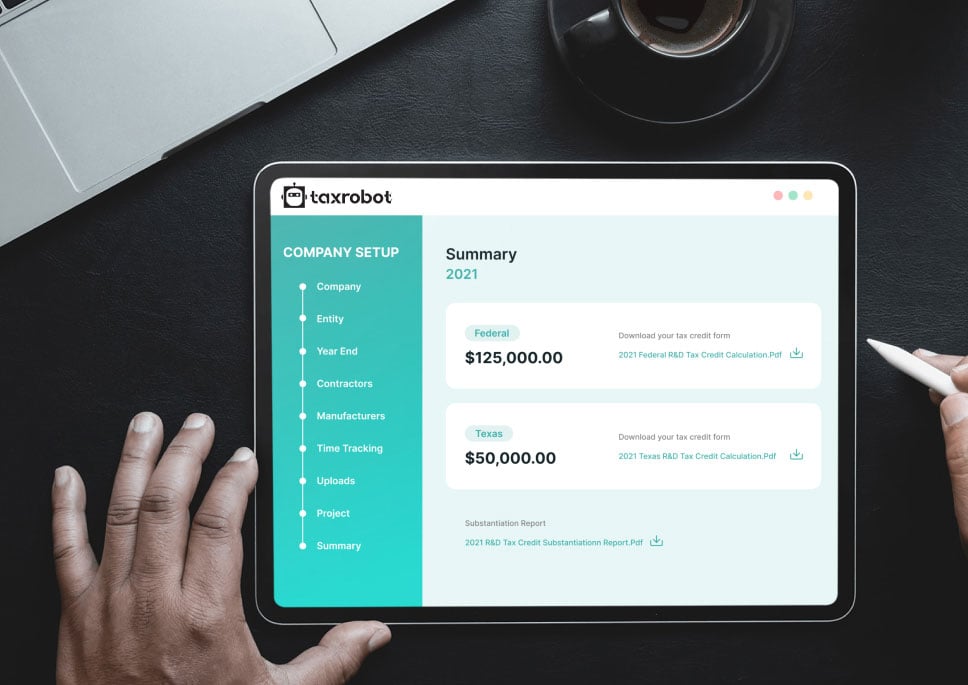Tennessee R&D Tax Credit
Step into the future of Research and Development (R&D) tax credits with TaxRobot. Our sophisticated AI-powered software is engineered to revolutionize your R&D tax credit claim process, ensuring accuracy, efficiency, and maximum refunds for businesses throughout Tennessee.
Maximize your State Credits today!
Put the R&D tax credit process on autopilot.
Trusted By:








Tennessee R&D Tax Credits
Discover your eligibility for Tennessee R&D tax credits and supercharge your enterprise.
Embrace Innovation with TaxRobot's R&D Tax Software
TaxRobot harnesses the power of artificial intelligence to simplify the complex world of R&D tax credits. By integrating with your existing accounting and payroll systems, our software identifies qualifying activities and expenses according to the most recent IRS guidelines. Here’s how it works:
- Input Your Information: Provide relevant details about your business and its R&D activities.
- Connect Your Systems: Allow TaxRobot to meticulously identify qualifying activities and expenditures.
- Claim Your Credits: TaxRobot calculates your potential R&D tax credit, providing a detailed report ready for submission to the IRS.
Why Choose TaxRobot for Your Tennessee Business?
Bigger Refunds
Our AI-powered software is designed to identify every eligible activity and expense, ensuring you receive the maximum possible refund. We leave no stone unturned when it comes to maximizing your R&D tax credits.
Save Time
The process of claiming R&D tax credits can be time-consuming and complex. TaxRobot simplifies this process, saving you valuable time that can be invested back into your business.
Superior Documentation
TaxRobot assists in compiling and organizing all necessary documentation for your R&D tax credit claims. This ensures you’re well-prepared for any potential audits and helps to streamline the claiming process.
Understanding the R&D Tax Credit in Tennessee
The R&D tax credit is a program introduced by the government to encourage innovation and boost the economy in industries. It incentivizes companies that invest more in research and development within the country.
If you’re a business operating in Tennessee in growing sectors like healthcare, automotive, and technology, these credits can significantly reduce your tax obligations and increase your cash flow.
Stay Ahead with TaxRobot in Tennessee
Tennessee is seeing rapid growth in sectors like automotive manufacturing and healthcare technology. As the state continues to innovate, the opportunities for claiming R&D tax credits are expanding. TaxRobot stays updated with these changes, ensuring your business doesn’t miss out on any potential credits.
Start Your Journey with TaxRobot Today
Navigating the intricacies of R&D tax credits doesn’t have to be stressful. With TaxRobot, you have a reliable partner dedicated to maximizing your R&D tax credits while providing excellent customer service.
Experience the future of R&D tax credits today. Contact us at TaxRobot and let our AI-driven software and team of experts guide you through the process.
Frequently Asked Questions
Is the R&D tax credit worth it?
Unlock the incredible advantages of the R&D tax credit! Here’s what you can expect:
- Earn up to 12-16 cents of federal and state R&D tax credits for every qualified dollar
- Enjoy a dollar-for-dollar reduction in your federal and state income tax liability
Discover the power of maximizing your potential with the R&D tax credit! Contact us at TaxRobot to learn more.
Are there any other benefits to the R&D tax credit?
Yes! The R&D tax credit offers an opportunity to foster innovation and enhance cash flow. When you take advantage of these credits, you can reinvest in initiatives and incorporate cost-efficient solutions into your business strategy. Moreover, it serves as a means to attract investors and demonstrate your steadfast dedication to long-term expansion.
What are the rules for R&D tax credits?
To qualify for R&D tax credits, it is crucial to contribute to technological progress in your field. If you haven’t developed any tools, improved existing products, or made changes to your processes or services in the last two years, you might be overlooking a thrilling opportunity. Don’t allow potential advantages to pass you by. Delve into the possibilities and unlock the benefits of R&D tax credits!
Take a sneak peak

- Limited Time Offer
- Simple Onboarding
- Easy to Use
R&D Tax Credits FAQs
The four-part test as outlined in the Internal Revenue Code is used to determine qualified R&D activity.
The Four-Part Test
1). New Or Improved Business Component
Creation of a new product, process, formula, invention, software, or technique; or improving the performance, functionality, quality, or reliability of existing business component.
- Construction of new buildings or renovation of existing buildings
- Invention of a software application
- Manufacturing of a new product or the improvement of the production process for an existing product
- Creation of design documentation
2). Technological In Nature
The activity fundamentally relies on principles of the physical or biological sciences, engineering, or computer science. A taxpayer does not need to obtain information that exceeds, expands or refines the common knowledge of skilled professionals in a particular field.
- Physics (relationship between mass, density and volume; loading as the
result of gravitational attraction) - Engineering (mechanical, electrical, civil, chemical)
- Computer science (theory of computation and design of computational systems)
3). Elimination Of Uncertainty
Uncertainty exists if the information available to the taxpayer does not establish the capability or method for developing or improving the business component, or the appropriate design of the business component.
- The capability of a manufacturer to create a part within the specified tolerances
- The appropriate method of overcoming unsuitable soil conditions during construction
- The appropriate software design to meet quality and volatility requirements
4). Process Of Experimentation
A process designed to evaluate one or more alternatives to achieve a result where the capability or method of achieving that result, or the appropriate design of that result, is uncertain as of the beginning of the taxpayer’s research activities.
- Systematic process of trial and error
- Evaluating alternative means and methods
- Computer modeling or simulation Prototyping Testing
The R&D tax credit is one of the most misunderstood tax incentives available. Considering the myriad of industries and activities that legally qualify for the credit, the term “research and development” is a misnomer. Additionally, the R&D tax credit requires specialized knowledge and technology to identify and calculate the incentive properly.
Companies of various industries are unaware that they are eligible to claim the R&D tax credit. Under the Internal Revenue Code’s definition of R&D, many common activities qualify. You can get tax benefits for industries including software, technology, architecture, engineering, construction, manufacturing, and more.
The R&D tax credit can be claimed for all open tax years. Generally, open tax years include the prior three tax years due to the statute of limitations period. In certain circumstances, the law allows businesses to claim the R&D tax credit for an extended period of time. It is common for companies to amend previous tax years to claim this benefit and reduce the maximum amount of tax liability.
Partnerships and S corporations must file this form to claim the credit. The credit will flow from the Form 6765, to the Schedule K-1, to the Form 3800 on the individual’s tax return. For individuals receiving this credit that have ownership interest in a partnership or S corporation, Form 6765 is not required on the individual return.
Individuals claiming this credit can report the credit directly on Form 3800, General Business Credit if their only source for the credit is a partnership, S corporation, estate, or trust. Otherwise, Form 6765 must be filed with the individual’s tax return (e.g. sole proprietorship).
For tax years prior to 2016, the credit can be used to reduce the taxpayer’s regular tax liability down to the tentative minimum tax. The credit cannot be used to offset alternative minimum tax. Beginning in tax year 2016, eligible small businesses have expanded utilization for the credit. For these eligible small businesses, the regular tax liability can offset alternative minimum tax using the “25/25” rule.
What our customers have to say
I highly recommend TaxRobot to anyone considering an R&D Tax Credit software to complete their analysis.

We decided to switch to TaxRobot… Best decision we’ve ever made. More affordable, and less complicated.

I couldn’t believe how easy it was! In under an hour, we saved enough money to hire a new employee.
